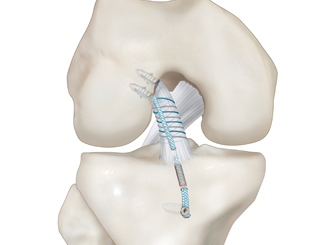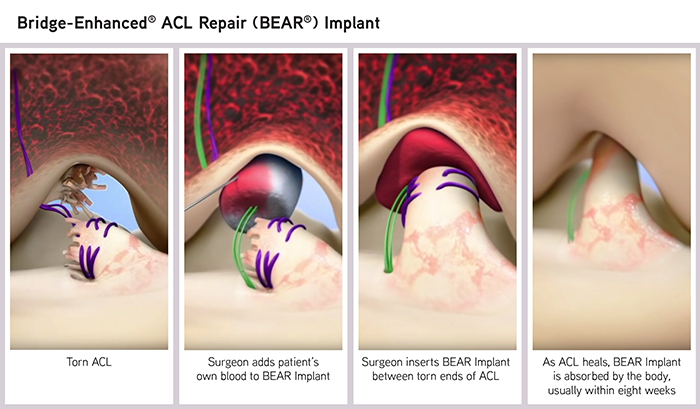Pediatric ACL Repair
In specific cases, ACL repair may be considered as a treatment option for a partial ACL injury. Because of vascularity supply within the ACL and healing potential, the location of the partial ACL tear plays a critical role in the decision to repair or not. The Sherman classification describes the location of an ACL tear and is used when categorizing ACL tears that indicate potential repair. A Sherman Type I injury is an ACL avulsion injury from the top of the femoral notch. A Sherman Type II injury is a tear through the substance of the upper one-third of the ACL. Primary Sherman Type I or II ACL injuries with good tissue quality and no other concomitant ligamentous injury can be considered for potential ACL repair. Additionally, in order to optimize tissue quality, it is essential to repair an ACL as close to the time of injury as possible once a patient has 0-90 degrees of range of motion restored. Ideally, this time period is less than 40 days from the date of injury.
Arthroscopic primary repair is minimally invasive. Since no grafts need to be harvested, the surgical incision is smaller than that of an ACL reconstruction with an autograft. Nonmetal anchors and sutures are used for re-attachment and re-tensioning of the ACL remanent during the surgical procedure. The goal of the procedure is to preserve the remnant native ACL. By doing this, the native nerve endings and blood supply are preserved, and promote healing as well as preserve proprioception.

When an ACL injury is suitable for arthroscopic repair, Dr. Chahla will also discuss the option of augmenting the repair with the use of the BEAR technique: Bridge-Enhanced ACL Repair. Due to our body’s natural supply of synovial fluid within the knee joint, the ACL is naturally unable to heal because blood clots cannot form, meaning that the healing components of our blood, such as platelets, coagulation factors, growth factors, and fibrin, cannot be supplied to the damaged ACL tissue. However, the BEAR implant is designed to hold the body’s own blood within the gap of the ACL injury to allow for the formation of the blood clot and subsequent healing process to occur. In other words, the BEAR implant acts as a bridge between the torn edges of the ACL as it heals. Although short term data regarding the use of the BEAR implant in ACL repairs has been promising, we are still learning the long-term outcomes of the surgical technique.

Studies reporting outcomes of ACL repairs have shown encouraging results, including a promising potential for early healing, good functional outcomes, and quicker initial recovery. However, full return to sport is the same as ACL reconstruction: 9 months post-op.
In select cases, a torn ACL can be repaired rather than reconstructed, particularly in younger patients with specific types of injuries. ACL repair involves reattaching the ligament rather than replacing it with a graft, potentially leading to a quicker recovery. Dr. Jorge Chahla carefully evaluates pediatric ACL injuries to determine if repair is a suitable option. If your child has an ACL tear and you are considering surgical treatment, schedule a consultation with Dr. Chahla in Chicago, Naperville, or Oak Brook to discuss the best approach.
At a Glance
Dr. Jorge Chahla
- Triple fellowship-trained sports medicine surgeon
- Performs over 700 surgeries per year
- Associate professor of orthopedic surgery at Rush University
- Learn more
